The Dark Souls remaster was recently released, but it doesn't make enough [single player] improvements for me to really care to buy it. I might pick it up for the Switch when that gets released, because portable Dark Souls could be fun and interesting and fresh enough to warrant another purchase. However, the Switch version is being developed by another company, and it doesn't even support 60 fps, so I may not bother getting it anyway.
In the meantime, I decided to try out another "remaster" of sorts, and I got some friends together for some jolly cooperation in Steamforged Games' Kickstarted Dark Souls: the Board Game. This is a co-operative dungeon-crawler. I think the closest comparison that I can make is that it's a Dark Souls-themed variation on Descent: Journeys in the Dark. Unfortunately, Dark Souls: the Board Game doesn't seem to hold a candle to Descent.
Opening the box sets the tone of the game right away.
YOU DIED
The big mechanic that is imported from the video game is the inclusion of the video game's bonfire and respawn mechanics. Like in the video game, resting at the bonfire (or dying and being returned to the bonfire) resets everything. This includes all enemy encounters, as well as all the players' resources (such as the Estus Flask, Lucky Coin, or Pendant -- which actually has a function in the board game). However, a bit of the sense of attrition is also lost in translation, as your HP (and stamina) fully resets after each encounter. I think I would have preferred if the Estus Flask had a certain number of uses, but only restored a subset of your damage. That way, you'd retain some of your damage from encounter to encounter.
All the party's souls are dropped
on the spot where a character died.
Nevertheless, the Bonfire mechanic is probably the one mechanic that is most successfully translated from the video game source material. Despite the lack of health attrition, the desire to conserve as much resources as possible for the upcoming boss fight pressures the players into riskier play. Trying to conserve resources can lead to a lot of deaths.
Just like in the video game, if you die, all your souls are dropped on the floor where you died. If any one player dies, the whole party "dies" and is transported back to the Bonfire. The deeper into the dungeon you died, the more you have to fight through [again] in order to reclaim your souls. If you die again before reclaiming your dropped souls, all those souls are lost.
As I understand the rules, you can't leave an encounter once it's started, so you won't be making any "soul runs" to pick up your souls and then run back to the bonfire. You also can't open treasure chests until the encounter is won, which means you can't make suicidal "loot runs" either, which are a trademark strategy of the Souls video games. If you need to level up or buy new equipment in order to beat the encounter that killed you, you'll have to risk losing your dropped souls by farming against other encounters... [More]
36444b16-5d29-4691-9a3f-d2609ffee548|0|.0
Tags:Dark Souls, Dark Souls: the Board Game, Steamforged Games, Kickstarter, From Software, board game, dice, miniatures, grinding, co-op, David Carl, Alex Hall, Mat Hart, Richard Loxam, Hidetaka Miyazaki
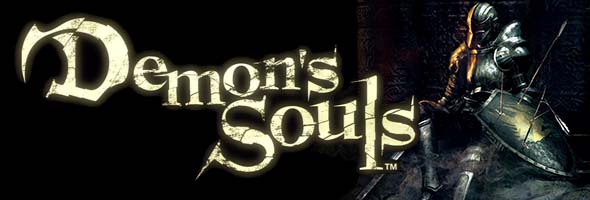
Rumors of a Demon's Souls remaster or remake have been floating around for a while now (as have rumors of a sequel). I have mixed feeling on the idea of a remake/remaster. On the one hand, Demon's Souls is one of my favorite games ever and may represent the peak of the series. Naturally, I want more people to play it and recognize its brilliance.
On the other hand, my fondness for the game means that I am hesitant to allow anyone to modify the game at all. After suffering through the abysmal Silent Hill HD Collection, I have strong reservations about any game remastering. Even the announced remake of Shadow of the Colossus has me on edge.
Matthewmatosis has posted an excellent retrospective look at how the subsequent
Souls games failed to live up to Demon's Souls' brilliance and originality.
Sadly, a remaster would probably mean that the servers for the original game would finally get shut down. But I guess having a replacement would be better than having no Demon's Souls at all...?
So with Dark Souls having come to its end with its Ringed City DLC, I've been thinking a lot lately about what I might want to see in any potential Demon's Souls remake or remaster -- if it were to happen.
Table of Contents
[More]
818fbc94-0834-4de0-9bd0-2664cf9988c8|1|5.0
Tags:Demon's Souls, From Software, Boletaria, remake, remaster, reboot, sequel, boss, soul, Old Monk, online, multiplayer, co-op, PvP, grass, Estus Flask, poise, item burden, equipment burden, crystal lizard
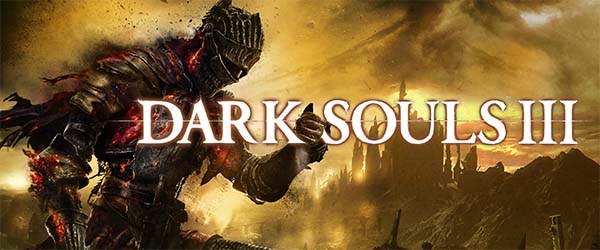
Table of Contents
What the hell does poise do?!!
In my review, I noted that poise seemed to have been turned off in the game's code. Well, FROM Soft has apparently stated that poise is working as intended. Really? How? What does it do? FROM was not forthcoming (so far) with any details on what the stat is supposed to actually do, other than to say that it is "more situational". Ok, whatever. So I guess it's up to the community to try to figure out how this stat apparently works, since it doesn't work in any way comparable to the previous games, nor does it seem to solve the problem that the original implementation of poise was intended to solve.
UPDATE Nov 16, 2016:
It looks like we've finally figured out what Poise does in Dark Souls III. It seems to only be activated when using large weapons that provide Hyper Armor.
I had previously believed that Poise functioned as an "escape method" from quick, stun-locking weapons (like daggers). My early interpretation of Poise was that a higher Poise value may allow the player to escape from a stun lock and be able to roll / counter-attack / parry after 3 hits rather than 5 or 6 consecutive hits. I even remember testing this hypothesis out and finding it to hold true. This would also apply to situations in which a player gets attacks from multiple enemies simultaneously (or in quick succession). Higher Poise would allow you to escape from the 3rd enemy's attack, rather than the 4th or 5th. But according to the Wiki, this doesn't seem to be the case. Am I wrong?
If it is true that Poise only affects Hyper Armor, then I'm still not happy with the mechanic, as it only applies to very specific builds, and might as well be a stat on the weapon rather than a feature of armor. But if it does also affect the ability to escape stun locks, then I guess I would be a little bit more satisfied.
Poise was originally intended to act as a counter to extremely fast weapons like daggers, rapiers, and so on, that could quickly hit and stagger an opponent and put them in a stun lock from which they couldn't escape (so long as the attacker still had stamina). It was also intended to give players with slower weapons an opportunity to tank their way through hits with such fast weapons. You'd still take damage, but assuming your attack with a stronger, slower weapon did more damage than your opponent's weaker, faster weapons, then the trade-off would still be in your favor. If you were going to use a very slow weapon, then it behooved you to also equip heavy armor and other poise-boosting equipment so that you could tank through opponents' hits. That doesn't seem to be the case anymore. A knight in full heavy armor should not get stun locked in a 10-hit combo from a dagger. It simply shouldn't happen. This is what poise was designed to prevent, and it's not doing its job. If an invader shows up in your world with an estoc, and you aren't an expert at parrying, then you might as well just offer up your head on the chopping block and get it over with.
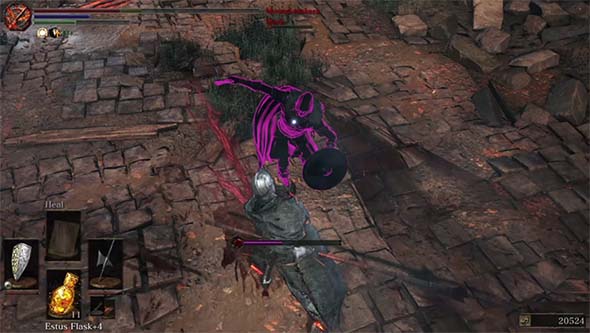
Without poise, heavy armor is worthless, and daggers are incredibly overpowered against slower combatants.
Without poise in this form, heavy armor simply isn't worth its weight encumbrance, especially since you can't even upgrade it to increase its damage resistance. This was a problem in Demon's Souls, which didn't have poise. Heavy armors generally didn't reduce damage enough to be worthwhile, they prevented the player from effectively rolling, and they were so heavy that they prevented the player from being able to pick up all the loot in a level because that game also had an item burden. Rolling was the end-all-be-all of defense in Demon's Souls, and that was one of the game's greatest weaknesses. It was easy to overlook because the developers didn't know better at the time. But they do know better now. Was poise exploitable in Dark Souls? Sure. It was really exploitable in Dark Souls II due to its connection to hyper armor and the inclusion of farmable healing items. But whatever FROM Soft did to it in DSIII seems like a severe overreaction.
Once I learned that poise wasn't working the way I expected it to, I gave up on trying to engage a lot of enemies with my slow halberd. Instead, I started fighting the knights in Lothric Castle and the Grand Archives with my flame-infused barbed straight sword - which I also spent a bunch of titanite to fully upgrade. This speedier weapon allowed me to attack these knights as fast (or faster) than they could attack me, giving me enough of an edge to reliably beat them. The ones with the tower shields and lances still gave me trouble, but the swordsmen fell swiftly to my +10 Barbed Flame Sword. Even Yahtzee noted in his Zero Punctuation review the starting long sword seemed better than any of the numerous boss weapons that he found. I imagine that this is because he also had trouble with the lack of poise, but didn't quite figure out that poise wasn't working.
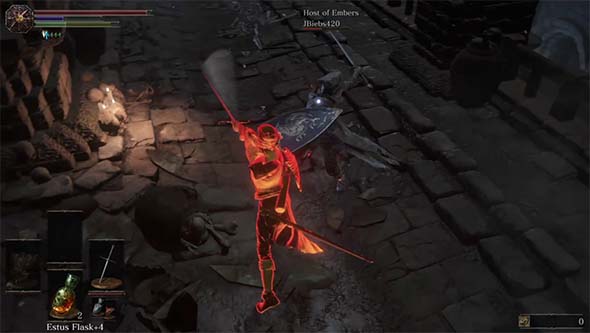
Lack of proper poise allows the estoc's reach and speed to make it a deadly PvP weapon.
So this leaves us with the question of "what, exactly, is poise intended to do?"...
[More]
9fc5b24e-c771-4f00-81da-f9aa41f3eb5f|1|5.0
Tags:Dark Souls, Dark Souls III, poise, PvP, co-op, covenant, phantom, summon, invader, invasion, friendly fire, NPC, Siegward, Siegward of Catarina, Patches, Unbreakable Patches, Anri, Anri of Astora, Yorshka, Blades of the Darkmoon, Darkmoon

PC elitists now have yet another bragging point. Considering that Bloodborne ran smoothly at 30 frames per second on the PS4 (from my experience), and that Dark Souls III was supposedly built upon that same engine, I expected that the PS4 version would perform on par with (or maybe even better than) the PC version. I was wrong. Both console versions of Dark Souls III are capped at 30 fps, but their actual performance doesn't even meet that standard. This is a big problem considering that the game plays almost as fast as Bloodborne. Dropping a few crucial frames of enemy attack wind-ups can mean the difference between a successful dodge or parry, or losing a third of your health to a single attack. Bloodborne had the load screen issue that was that game's near-debilitating "known shippable"; and now Dark Souls III has its console framerate as being the major launch issue that must be fixed. At least Bloodborne's problem didn't impact actual gameplay...
Table of Content
A challenge to Souls fans
This is probably the hardest game in the lineup. In fact, it may even be too hard in some ways. Enemies are very aggressive and relentless, they are very fast and swift at attacking, and they are very good at tracking your movement during an attack. I feel like the game is sadly front-loaded with excessive difficulty. Oh, don't get me wrong! It's hard throughout, and there's still some definite mid-and-late-game peaks of difficulty. But this game easily has the highest barrier to entry of any game in the lineup.
Dark Souls III is very hard and very much front-loaded with difficulty.
It's one thing to provide a challenge, but the early levels of this game maybe cross the line into outright cruelty. If I weren't already invested in the series, I might not have even made it past the Lothric knights in the High Wall. Yeah sure, Demon's Souls had the Red Eye Knights, and Dark Souls had the Black Knights, and Bloodborne had the warewolves; but in those cases, those difficult enemies were blocking optional paths and items. This is why I can kind of tolerate the mutating tentacle monster on the rooftop that hits very hard, has a ton of HP, obscures half the screen, and causes an annoying framerate drop. Yeah, it's located in a critical path of the level, but it can be easily avoided and is basically just guarding a crystal lizard. The difficult Lothric knights, on the other hand, are placed in critical bottlenecks that must be passed as part of the necessary path of progression through the level, and they will shred new players to pieces! Heck, even that fat, winged knight going around in circles in the courtyard is easier than the Lothric Knights.
And then you get to the Undead Settlement, which is a maze full of ambushes and difficult enemies. Those fat evangelists and the large cleaver undead hit hard and have deceptively long reach and multi-hit combos. This is at a time when your HP and stamina are so low that you can't reliably block their attacks. Their long reach and relentless aggression means you can't back away either. So you're stuck having to stick to close range and roll through their attacks - a maneuver that can result in a quick death if you make but a single slip-up. I had a lot of trouble handling these enemies (as I was still getting used to the new timings for dodging and parrying, and the stamina requirements for blocking), and so I imagine that many rookies will likely be completely overwhelmed.
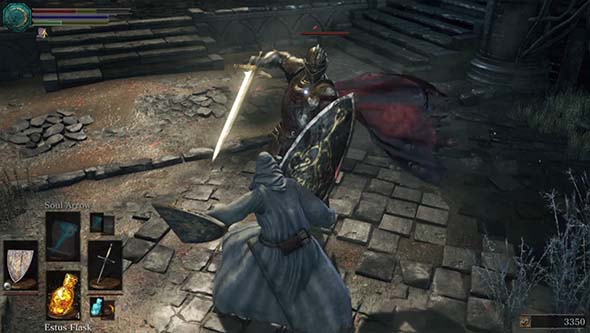
Dangerous enemies have narrow windows for parrying their attacks, making it hard to practice this technique.
There's a higher skill floor than in previous titles, and the game demands a further degree of mastery of rolling, stamina management, i-frames, and weapon movesets that previous games simply didn't require. Bloodborne also toes with this line, but Dark Souls III seems to go a bit further. The problem here is that enemies become far too fast and deadly far too early in the game, and the player character remains slow and relatively weak. What's worse is that the game breaks with the original's insistence on fair difficulty by apparently completely failing to enforce the rules regarding stamina for enemies! This was also a problem in Dark Souls II, but it didn't bother me quite as much because those enemies had slower attacks that were generally easier to dodge.
There's no gradual ramping up of challenge for the player to learn things like roll and parry timings, and there aren't any large, slow enemies to practice these techniques against. Bloodborne had very fast enemies to go with its very fast combat, but the character was also equally fast. Bloodborne also had the Brick Trolls, whose telegraphed attacks gave plenty of opportunity to practice parrying in the very first level while still making progress. Dark Souls III simply doesn't have this. There's the undead spearmen that are easy to parry, but they're so slow and defensive that you'll likely just get bored waiting for them to attack and miss your opportunity to parry. Sure you could go back to the tutorial level to practice parrying, but then you're not making any progress. There's also a lot more instances early of mobs, including the presence of difficult casters (or even bosses) being among those mobs. Fortunately, the boss is very slow and lumbering, and the casters have good audio cues for when they're casting that help to make these mobs less frustrating to deal with.
The big, armored elephant in the room
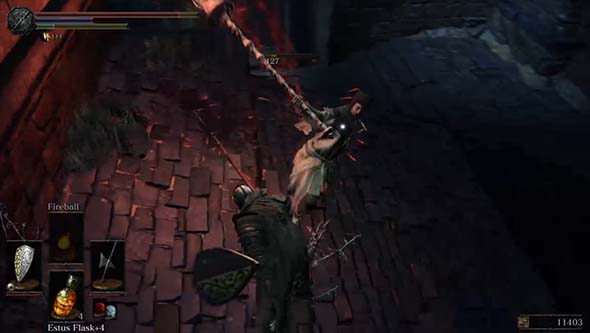
Poise has been disabled for players, which means enemies will always stagger you, but you might not stagger them.
Perhaps the biggest contributor to the game's difficulty early on is the completely baffling way in which poise and defense work - which is that they don't. In addition to not being able to upgrade armor to improve its defenses, the poise stat appears to have been completely disabled for all players in the game's code for ... some reason. Poise was one of the best additions from Dark Souls 1, and its apparent removal completely baffles me. Is it bugged and they're planning on fixing and enabling it later via a patch? Is it planned to be part of DLC? "Hey, want poise back? Pay $15 for this DLC!" The value still shows up in the UI, and there's still rings and weapons that exclusively improve poise, so it definitely seems like FROM intends for poise to be in the game. The enemies seem to still have poise, so this situation seems completely unfair. This might be part of the reason why the start of the game feels so difficult, since those damned speedy Lothric Knights can hit through your attacks, but you can't hit through theirs! [More]
fad05dd1-7cd5-454e-9102-9178f6fa617e|5|3.6
Tags:Dark Souls, Dark Souls III, From Software, Namco/Bandai, PlayStation 4, PSN, XBox One, XBox Live, PC, Steam, online, multiplayer, co-op, PvP, invasion, phantom, covenant, Lord of Cinder, Firelink Shrine, Demon's Souls, Nexus
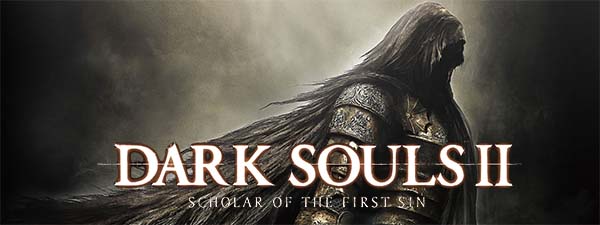
Hot off of playing Bloodborne's The Old Hunters DLC, and with Dark Souls III just over the horizon, I thought I'd get myself hyped up by playing through the re-release of Dark Souls II, Scholar of the First Sin. This version of the game is a next-gen enhancement of the original game that was released on the PS3, XBox 360, and PC a year prior, and it includes improved graphics, faster frame rate, and more challenging enemy-placement. It's available on PS4, XBox One, and PC, and is treated as a completely different game as the original version. It's not a DLC or a patch update (though it does include all three of Dark Souls II's DLC content).
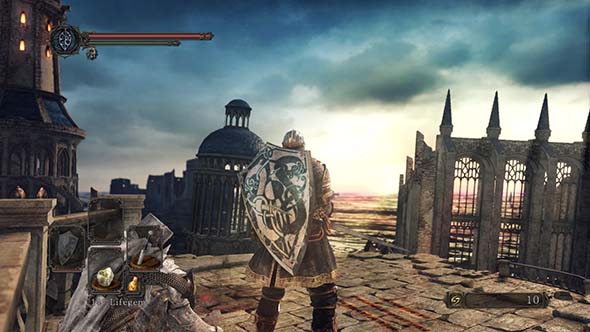
Scholar of the First Sin looks much smoother in motion, with higher resolution and framerate.
Lighting and textures are (at best) only marginally improved from the last-gen release.
I was honestly expecting Scholar of the First Sin's graphics to be considerably better than they are. In fact, I honestly don't think the graphics are much better than the last-gen release; I think the only difference is that it displays at full 1080 resolution and plays at a high end of 60 frames per second. Colors are a little more vibrant, and the game doesn't look as washed-out, but models and environments don't seem any more complex, and textures are only maybe slightly more detailed. Unfortunately, darkness still isn't as dark as it needs to be to make the torch as necessary for exploration as it was apparently intended to be. In pre-release demos, darkness was implied to be a complete fade to black that rendered objects within the dark invisible. Simply adjusting the brightness of your TV wouldn't change that. In the released version, darkness doesn't go completely black, so objects are only hidden if your TV brightness is low - lower than the recommended brightness level of the game. Even then, the release game looks brighter, and Scholar of the First Sin does very little to change that.
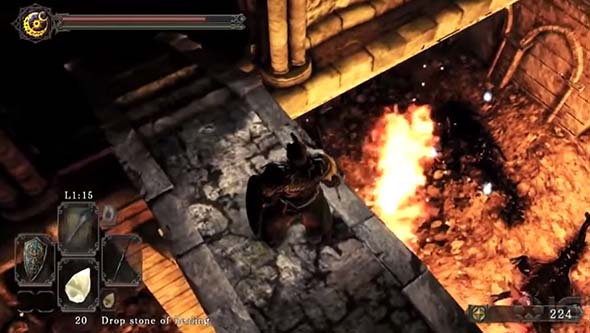
PREVIEW FOOTAGE showcased greater contrast between light and dark, and more detailed textures and geometry...
This graphical downgrade, the complete failure of FROM or Namco/Bandai to inform the public about it, and the resultant misleading marketing that repeatedly showed demos, screenshots, and footage that wasn't representative of the final product left a huge negative impression on a lot of players - especially those who pre-ordered it. That poor initial taste is probably a huge part of the reason why this game has gotten such a negative reception, even though that negative reception is mostly warranted. Scholar of the First Sin was an opportunity to wash that bad taste out of consumers' mouths and give us the game that was advertised, marketed, and pre-ordered. But Namco and FROM didn't bother.
Darkness is just rarely ever a meaningful component of the gameplay. Darkness may lower the range of target locks though, so even though I could plainly see enemies, I felt like I wasn't able to target lock them as readily as I could in the PS3 version. Even so, there's enough sconces laying around that you can light a sconce, extinguish your torch to fight, then re-light it at the sconce after all the enemies have been dispatched. It ends up just being some extra overhead if you care enough to bother with it, and not an essential element of gameplay.
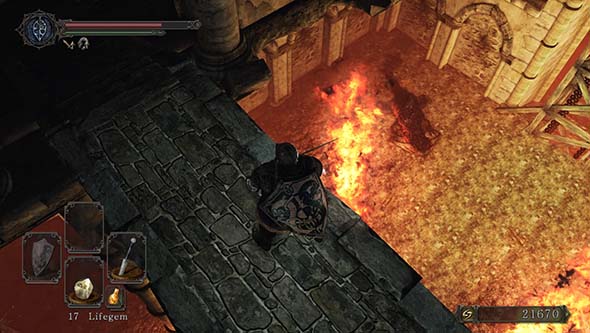
... FINAL PRODUCT shows low contrast between light and dark, frequent repeated textures, and simplified geometry.
Textures, character models, and world geometry don't look noticeably better. Many areas still have generally blander textures than what was presented in pre-release videos, and the textures noticeably repeat. World geometry also seems less detailed and intricate compared to pre-release videos, which takes away a lot of the personality that these preview areas exhibited. I was expecting Scholar of the First Sin to restore many of these superior textures and models from the previews, and I'm really disappointed that the game doesn't look better than it does.
Darker contrast in previews [LEFT] made real-time shadows more vibrant,
and creatures more threatening and mysterious than in the release build [RIGHT].
The improved textures also don't do much to help the game's generally bland art design. There aren't many visually-appealing locations in the game, as they are all just variations of run-down castles and forest paths. Most of them have pretty sparsely-decorated hallways with simple geometry that has little-to-no personality. There's nothing here that even approaches the ominousness of Demon's Souls' Latria, and the oppressive environments of Bloodborne make Dark Souls II almost serene by comparison. Again, Scholar of the First Sin does little-to-nothing to address this. No Man's Wharf probably remains my favorite location in this game, as it's one of the few locations that takes place in a fairly unique setting that actually utilizes light and dark for gameplay purposes.
So while the visual upgrade doesn't really add much to the game, the higher framerate definitely does make a noticeable difference. The PS4 doesn't seem to maintain a full 60-fps at all times, but it seems to always run better and smoother than the 20-30 fps of the PS3 version. Animations are much smoother, and ambient effects (such as foliage swaying in the wind) look much better. I admittedly had to spend some time re-adjusting to the game's speed. After coming back from the rapid pace of Bloodborne, this game almost seemed to be moving in slow motion, and the higher framerate probably contributed greatly to that sensation. That's not necessarily a bad thing; it's just a stylistic difference. Scholar of the First Sin plays smoothly (on the PS4), and it looks decent (even though it should have looked better)... [More]
ac8d6f88-ca6d-4def-983d-10eea4ed035b|2|4.0
Tags:Dark Souls II: Scholar of the First Sin, Dark Souls II, Dark Souls, From Software, online, PvP, co-op, covenants, summon, invader, invasion, phantom, shade, soapstone, covenant, torch, DLC, Crown of the Sunken King, Crown of the Old Iron King, Crown of the Ivory King
|

| 12 | | | | | | | 60 | | 11 | | | | | | | 55 | | 10 | | | | | | | 50 | | 09 | | | | | | | 45 | | 08 | | | | | | | 40 | | 07 | | | | | | | 35 | | 06 | | | | | | | 30 | | 05 | | | | | | | 25 | | 04 | | | | | | | 20 | | 03 | | | | | | | 15 | | 02 | | | | | | | 10 | | 01 | | | | | | | 05 |
|